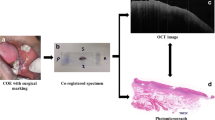Abstract
Purpose
In the present study, we investigated the potential application of elastic light single-scattering spectroscopy (ELSSS) as a noninvasive, adjunctive tool to differentiate between malignant and benign oral lesions in vivo.
Methods
ELSSS spectra were acquired from 52 oral lesions of 47 patients prior to surgical biopsy using a single optical fiber probe. The sign of the spectral slope was used as a diagnostic parameter and was compared to the histopathology findings to obtain sensitivity and specificity of the ELSSS system in differentiating between benign and malignant tissues.
Results
The sign of the spectral slope was positive for the benign tissues and negative for the malignant tissues. Nine malignant lesions and one high-grade dysplasia were correctly classified as cancerous. Six out of the ten low-grade dysplasia were correctly classified as cancerous, and four of them were misclassified as benign. Thirty benign lesions were correctly classified as benign, and two were misclassified as malignant. Our results indicate that the sign of the spectral slope enables the differentiation between malignant and benign oral lesions with a sensitivity of 80% and specificity of 94%.
Conclusions
ELSSS has the potential to be developed as an adjunctive screening tool in the noninvasive evaluation of oral lesions in vivo. This new diagnostic system may reduce the number of unnecessary biopsies.



Similar content being viewed by others
References
Katsanos KH et al (2015) Oral cancer and oral precancerous lesions in inflammatory bowel diseases: a systematic review. J Crohns Colitis 9(11):1043–1052
Chandra A et al (2013) Oral squamous cell carcinomas in age distinct population: a comparison of p53 immunoexpression. J Cancer Res Ther 9(4):587–591
Foy JP et al (2013) Oral premalignancy the roles of early detection and chemoprevention. Otolaryngol Clin N Am 46(4):579
van der Waal I (2014) Oral potentially malignant disorders: Is malignant transformation predictable and preventable? Med Oral Patol Oral Y Cirugia Bucal 19(4):E386–E390
Abul AK, Fausto N, Kumar V (2017) Robbins & cotran pathologic basis of disease, 9th edn. Elsevier, Amsterdam, p 1408
Masthan KMK et al (2015) Leukoplakia: a short review on malignant potential. J Pharm Bioallied Sci 7(5):S165–S166
Yardimci G et al (2014) Precancerous lesions of oral mucosa. World J Clin Cases 2(12):866–872
Colletti G et al (2014) Contemporary management of vascular malformations. J Oral Maxillofac Surg 72(3):510–528
Moneghini L et al (2017) Head and neck vascular anomalies. A multidisciplinary approach and diagnostic criteria. Pathologica 109(1):47–59
Petti S (2003) Pooled estimate of world leukoplakia prevalence: a systematic review. Oral Oncol 39(8):770–780
Scheifele C, Reichart PA (2003) Is there a natural limit of the transformation rate of oral leukoplakia? Oral Oncol 39(5):470–475
Mashberg A (2000) Diagnosis of early oral and oropharyngeal squamous carcinoma: obstacles and their amelioration. Oral Oncol 36(3):253–255
Denkceken T et al (2016) Diagnosis of pelvic lymph node metastasis in prostate cancer using single optical fiber probe. Int J Biol Macromol 90:63–67
Denkceken T et al (2013) Elastic light single-scattering spectroscopy for the detection of cervical precancerous ex vivo. IEEE Trans Biomed Eng 60(1):123–127
Canpolat M et al (2012) Diagnosis and demarcation of skin malignancy using elastic light single-scattering spectroscopy: a pilot study. Dermatol Surg 38(2):215–223
Turhan M et al (2017) Intraoperative assessment of laryngeal malignancy using elastic light single-scattering spectroscopy: a pilot study. Laryngoscope 127(3):611–615
Canpolat M, Mourant JR (2001) Particle size analysis of turbid media with a single optical fiber in contact with the medium to deliver and detect white light. Appl Opt 40(22):3792–3799
Backman V et al (2000) Detection of preinvasive cancer cells. Nature 406(6791):35–36
Mourant JR et al (1998) Mechanisms of light scattering from biological cells relevant to noninvasive optical-tissue diagnostics. Appl Opt 37(16):3586–3593
Sircan-Kucuksayan A, Denkceken T, Canpolat M (2015) Differentiating cancerous tissues from noncancerous tissues using single-fiber reflectance spectroscopy with different fiber diameters. J Biomed Opt 20(11):115007
Thong PS, Olivo M, Chin WW, Bhuvaneswari R, Mancer K, Soo KC (2009) Clinical application of fluorescence endoscopic imaging using hypericin for the diagnosis ofhuman oral cavity lesions. Br J Cancer 101(9):1580–1584
Guze K, Pawluk HC, Short M et al (2015) Pilot study: Raman spectroscopy in differentiating premalignant and malignant oral lesions from normal mucosa and benign lesions in humans. Head Neck 37(4):511–517
Funding
This research received no specific grant from any funding agency in the public, commercial, or not-for-profit sectors.
Author information
Authors and Affiliations
Corresponding author
Ethics declarations
Conflict of interest
There is no potential conflict of interest.
Ethical approval
All procedures performed in studies involving human participants were in accordance with the ethical standards of the institutional and/or national research committee (approval reference 26062013/40) and with the 1964 Helsinki declaration and its later amendments or comparable ethical standards.
Informed consent
Informed consent was obtained from all individual participants included in the study.
Additional information
Publisher's Note
Springer Nature remains neutral with regard to jurisdictional claims in published maps and institutional affiliations.
Rights and permissions
About this article
Cite this article
Sircan-Kucuksayan, A., Yaprak, N., Derin, A.T. et al. Noninvasive assessment of oral lesions using elastic light single-scattering spectroscopy: a pilot study. Eur Arch Otorhinolaryngol 277, 1467–1472 (2020). https://doi.org/10.1007/s00405-020-05824-z
Received:
Accepted:
Published:
Issue Date:
DOI: https://doi.org/10.1007/s00405-020-05824-z




